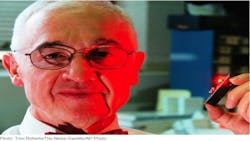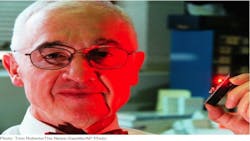Do Engineers Get Credit for Their Achievements – Ask Nick Holonyak Jr.
There is an old maxim that you should give credit where credit is due. Recent IEEE publications point out that isn’t always the case with the Royal Swedish Academy of Sciences that awards the Nobel Prize. It completely ignored Nick Holonyak Jr., (Fig. 1) the person widely credited with the development of the first visible-light LED. The 2014 Prize went to three inventors of the blue light-emitting diode, Holonyak’s name was not mentioned. Holonyak isn’t exactly complaining that he isn’t among them; his objection is that his 1962 invention has never been singled out for recognition by the academy. “Hell, I'm an old guy now,” Holonyak said in an interview with the Associated Press. “But I find this one insulting.”
But some of Holonyak’s colleagues are puzzled at the selection. “I can’t help but wonder why the committee chose to single out the blue light LED in their selection of the winners,” Andreas Cangellaris, dean of engineering at the University of Illinois, Holonyak’s home for many decades, told a reporter at The News-Gazette, a local newspaper. “Very puzzling and very disappointing.”
The story of the LED, goes back further than and well beyond Holoynak. Before Holonyak’s red LED, there was the infrared LED (along witheven earlier discoveries), and there is a host of other researchers who could share credit in the device’s development.
Indeed, The News-Gazette went on to say that Holonyak “was disappointed and irritated at the omission—not just for himself, but for many of his former students and colleagues who did groundbreaking work themselves.”
.Fig. 1. Nick Holonyak, Jr. inventor of the red LED (Tom Roberts/ The News Gazette/AP Photo).
Holonyak, who won the IEEE Medal of Honor in 2003, originally set out to develop a red diode laser. In the process, he also succeeded in creating a red LED. Holonyak and several of his colleagues later went on to use compound semiconductors similar to those used to create the first LED to develop a transistor laser, a device capable of emitting both electrical and optical signals.
Holonyak also made a couple of nice appearances online on the 50th anniversary of his invention: an audio slide show for the BBC and an excellent video interview for General Electric, where the device was made.
In announcing the 2014 prize, the Nobel Foundation highlighted the great potential social impact of blue LEDs, which made LED bulbs possible and could help dramatically reduce the amount of energy the world expends on lighting. However, there never would have been a blue LED if Holonyak’s red LED hadn’t preceded it.
Recipients of the 2014 Nobel Prize in Physics were Isamu Akasaki and Hiroshi Amano, who worked together at the University of Nagoya, and Shuji Nakamura, who worked at Nichia Chemicals in Tokushima, developed bright versions of the devices in the late 1980s and early 1990s.
“Their inventions were revolutionary,” the Nobel Foundation said in a press release. “Incandescent light bulbs lit the 20th century; the 21st century will be lit by LED lamps.”
The Nobel Foundation notes, Akasaki and Amano were the first to develop the high-quality gallium nitride used to make the blue diodes, beginning in 1986. The three lighting luminaries, all of whom are IEEE members (Akasaki is a Life Fellow), have won multiple IEEE awards including the IEEE Edison Medal and numerous IEEE Photonics Society Awards.
With the invention of these devices, engineers could now create white light by using blue light to excite a phosphor or by combining red, green, and blue devices. LEDs now light LCD screens, are slowly pushing aside incandescent and fluorescent lighting in homes and offices, and can be used to electronically control color to better mimic the diurnal cycle.
Development on the blue LED has continued steadily since its invention. One key challenge has been LED droop, a drop in efficiency when currents are raised to produce more light. Last year, a team of researchers claimed they’d found the source of the droop, but others weren't so confident. And engineering a way to circumvent it is another matter.
Divisive debate concerning the origin of the biggest flaw in the LED is now over, according to researchers from the University of California, Santa Barbara, and the École Polytechnique, in France. This team claims that it has categorically identified the cause of “droop,” a mysterious malady that leads an LED’s efficiency to decline as the current that passes through it is increased.
“In the experiment we do, there is a direct measurement of high-energy electrons, and the only source of [these] electrons is the Auger effect,” explains team member Claude Weisbuch, who argues that previous work identifying Auger as the cause of droop was just circumstantial. Auger recombination—an effect named after the 20th-century French physicist Pierre-Victor Auger—involves the interaction of an electron and a hole with another charge carrier, all without the emission of light.
The Auger effect occurs in LEDs when electrons and their positive counterparts—holes—are drawn together under an electric field and congregate in the so-called active region. Here, pairs of electrons and holes recombine to emit light. Auger effects also take place between two electrons and a hole to spawn a high-energy electron. This effect requires light bulbs with multiple LEDs running at a lower current. Eliminating this effect would reduce the number LEDs required in a bulb.
Now, if someone solves the Auger effect will they get a Nobel Prize?
Fig. 1. Nick Holonyak, Jr. inventor of the red LED (Tom Roberts/ The News Gazette/AP Photo).
About the Author

Sam Davis Blog
Editor-In-Chief - Power Electronics
Sam Davis was the editor-in-chief of Power Electronics Technology magazine and website that is now part of Electronic Design. He has 18 years experience in electronic engineering design and management, six years in public relations and 25 years as a trade press editor. He holds a BSEE from Case-Western Reserve University, and did graduate work at the same school and UCLA. Sam was the editor for PCIM, the predecessor to Power Electronics Technology, from 1984 to 2004. His engineering experience includes circuit and system design for Litton Systems, Bunker-Ramo, Rocketdyne, and Clevite Corporation.. Design tasks included analog circuits, display systems, power supplies, underwater ordnance systems, and test systems. He also served as a program manager for a Litton Systems Navy program.
Sam is the author of Computer Data Displays, a book published by Prentice-Hall in the U.S. and Japan in 1969. He is also a recipient of the Jesse Neal Award for trade press editorial excellence, and has one patent for naval ship construction that simplifies electronic system integration.

